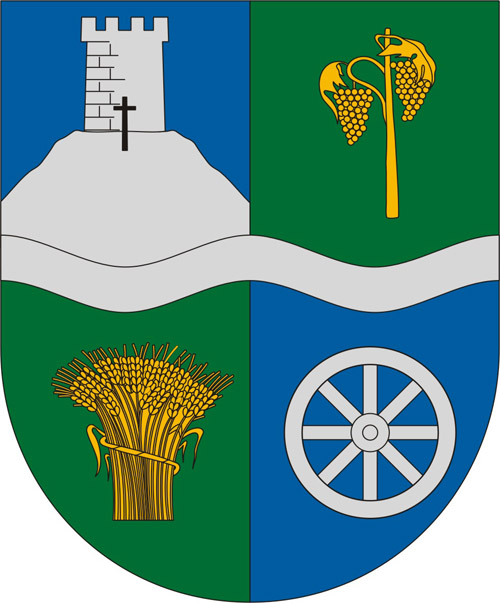
(Zala megye)
Álló, kékkel és zölddel negyedelt kerektalpú pajzs, pajzsközépen ezüst hullámpólya. Jobb pajzsfőn ezüst domb várral, bal pajzsfőn lebegő arany szőlőtőke. Jobb pajzstalpon lebegő arany búzakéve, bal pajzstalpon lebegő ezüst kerék.
A mai Kemendollár Kemend és Ollár községek egyesítésével jött létre, 1918-ban. Történelmük során
más-más események zajlottak , földrajzilag is különböző jellegzetes adottságaik voltak, illetve
jellemzőek ma is. A két településrészt a Zala folyó szeli át, meghatározva ezzel arculatát.
Levéltári kutatásaim során egyik településnek sem került elő címeres pecsétje, sem egyéb meglévő
címerre utaló dokumentum.
Az új címer megalkotásánál ezen kívül fontos szempont lehet a lehetőség un. beszélő címer
létrehozására. A településrészek néveredete, illetve konkrét jelentése erre nem ad módot.
A települések történelméből csak annyit említenék meg ami a címeralkotás szempontjából jelentős
volt.
A kemendi várdomb már az őskorban is lakott volt, első írásos említése 1236-ra datálódik, és váráról volt nevezetes. Ez a történelem során különböző nemesi családok birtokában volt,( Rohonci, gersei Pethő, Festetics ). A török megszállás alatt nagy jelentőséggel bírt, a Rákóczi szabadságharc után elpusztult és köveit pl. a pókaszepetki templom építéséhez hordták szét. A várrom ma műemlék. Kemendre jellemző volt még a szőlőhegyek fontossága, a szőlőművelés. Kemendi hagyomány, hogy az istállók régen a szőlőhegyen voltak, s az ottani barokk kápolnát Festetics Kristóf emeltette, Szent Kristófnak hálából. ( Szent Kristóf napi búcsúk! )
Ollár, Ollárpuszta, Olivántfa első írásos említése 1236-ra esik. Említik kőből épült vízimalmát, főbb birtokosai azonosak Kemendével, 1629-ben pusztaként említik, 1700-tól telepítik újjá. A Festetics uradalom egyik központja volt, a kastélyhoz bíráskodási hagyományok is fűződtek. A majorsági gazdálkodás jellemzően meghatározó volt a település fejlődésében, az itt élő emberek szemléletében. Mesterházy Jenő földbirtokos ténykedése és a jó közlekedési lehetőség lehetőséget adott a falu fejlődésének.
A címerterveken ennek megfelelően Kemendet egy várdomb ábrázolja a várral és a kereszttel, megjelenik még a szőlő ami az újjászülető élet fontos szimbóluma is. A címerpajzsokon megjelenő ezüst pólya, hullámpólya a zöld mezőket átszelő , a két településrészt összekötő folyó jelképe. A zöld mezőben megjelenő arany kerék ( kocsikerék, malomkerék ) utal a jellemző mezőgazdasági jellegre Ollárban, illetve a kerék a fejlődés, egyetemes körforgás szimbóluma. Az arany búzaszálak, illetve kévék a termékenység, bőség jelképei, mint az arany napkorong is.
(The County of Zala)
Shield erect and quarterly, azure and vert, its base is rounded. At fess a wavy bend argent. In dexter chief a mound argent. It is topped by the charge of a castle. In sinister chief a vinestock is borne encouped and or. In dexter base a sheaf of wheat is borne encouped and or, in sinister base the charge of a wheel argent is borne encouped.
Contemporary Kemendollár came into being in 1918, when the one-time villages of Kemend and Ollár got united. These two villages had been part of different historical events, and they had and still have diverse geographical characteristics. The two parts of the village are divided by the Zala river, the settlement’s most distinctive geographical feature.
During archival research work no coated seals were found. This is why the settlement’s coat of arms had to be newly created and one possibility for creating a new emblem is the use of the so called canting arms. Ont he other hand the etymology of the settlement’s name does not allow the creation of such an emblem.
The castle hill of Kemend was inhabited as early as the prehistoric age and its first written mention goes back to 1236. This part of the settlement was primarily known for its castle, which, in the course of history, was owned by several nobiliary families, including the Rohoncis, the Gerseis, the Pethős and the members of the Festetics family.) In the period of the Turkish Conquest of Hungary the castle had a special significance, but it got destroyed after Rákóczi’s war of independence. The building stones of the castle were later reused when the church of Pókaszepetk was being built. The ruins of the castle represent a historical site today. Kemend can also be characterized by viniculture and its vinehills. It was a local tradition that the stables used to be built on the vinehill. The Baroque chapel on the hill was erected by Kristóf Festetics with the aim of honoring St. Christopher. (The annual feast of the patron saint has a special significance until now.)
The first written mention of Ollár, Ollárpuszta and Olivántfa goes back to 1236. The settlement’s first water mill is worth mentioning in connection with local history. In 1629 it
was mentioned as an uninhabited settlement and it got rebuilt only in 1700. The settlement’s chief landowners were identical with those of Kemend. Kemendollár was one of the farming centres of the area and the owners of the castle also functioned as local judges, Farming was the chief source of living for the inhabitants. The activities of landowner Jenő Mesterházy as well as good local opportunities for transport served as bases for local development.
According to these characteristic features in the settlement’s coat of arms the castle hill, the local castle and a cross are represented. The grapes are symbols of new life and vitality. The silver bend, the wavy bend as well as the motives of the churh also appear in the settlement’s coat of arms. The wavy bend symbolises the river, which runs through the settlement. The golden wheel in the green field (the cart wheel, and the mill whell) all symbolise the settlement’s agricultural features and at the same time, they stand for the universal cycle of life. The golden ears of wheat and the sheafs of wheat are symbols of fertility and wealth. The golden disc of the sun is also a reference to wealth.